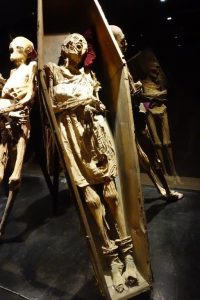At first it was the socks that got to me. On some you could see that what was once knee-length socks had long since fallen into dusty, crumpled mounds around their fragile, bony ankles. It was a little sad – okay, it was heartbreaking – to observe. It made these people look so helpless and vulnerable, like hapless children.
It brought to mind a British expression I learned when I lived in Anglophone southern Africa in my twenties: “Pull up your socks, man!” Which I interpreted then as, “Pull yourself together and get on with it, for goodness sake” (and do so with a stiff upper lip, of course). Good advice for the living. But these people with the fallen socks were quite dead.
Last week, when my friend Marie-Laure was visiting me here in Mexico from France, we took a day trip to the city of Guanajuato (capital of the state of Guanajuato, in which San Miguel de Allende also is). She, being an ace tourist who always does her homework in advance, wanted to see El Museo de Las Momias (the museum of the mummies), for which Guanajuato is rightly famous. “This museum is unusual,” Marie-Laure told me earnestly. “It’s not to be missed.”
I’d spent four months last summer in the impressive city of Guanajuato and never went near the mummy museum, judging it too, too creepy for my taste. I opted instead for some of the other museums the capital is noted for, such as Diego Rivera’s childhood home, which his daughter converted to a modern, world-class museum, and the Cervantes museum, which houses more Man-of-La-Mancha-inspired artwork than anywhere else in the world.
Guanajuato’s “darker sides” – its deep, dark, spaghetti-like tunnel system (like nowhere else in the world), and its macabre mummy museum – were not, to my mind, its shiniest attractions.
But Marie-Laure wanted to visit the mummy museum last week, so I pulled up my socks and went along.
I’m glad I did.
“The Mummies of Guanajuato,” as they are known, numbering over 100 in this museum, were naturally mummified after their interment during a cholera outbreak in Guanajuato in 1833. The museum is located above the spot where the mummies were first discovered. This museum is even said to have the smallest mummy in the world – a fetus from a pregnant woman who fell victim to cholera. Some of the mummies can be seen wearing parts of the clothing in which they were hastily buried. Hence, the socks.
(Note: I was not able to take pictures because flash cameras are not allowed. But Marie-Laure just sent me one of her photos, which I’ll attach here. Also, do Google the museum to see more of the mummies for yourself.)

Perhaps it’s a matter of time and acculturation. After a while (a long while, maybe) you see and accept that here in Mexico there’s a seemingly thinner line between the living and the dead than there is, for example, in the United States. In the States we tend to fear death and, for the most part, attempt to put it out of our minds. “We Americans walk toward death backwards,” I heard someone put it recently. Not so in Mexico. And not just when El Dia de Los Muertos (the Day of the Dead) arrives in November.
All year long and everywhere you look – among street vendors’ wares, tourist shops’ tchotchkes, and swanky galleries’ art – you’re faced with fancy-dressed skeletons and colorfully hand-painted skulls. These symbols of death are part of everyday life here. Skeletons are not only not hidden in closets, they’re put out on display.
Frankly, I’m finding this approach to the inevitable both honest and refreshing. Facing the real, once-live skeletons at the mummy museum brought this lesson home to me. “Look at me!” these people behind the glass cases there seemed to be pleading. “I was once just like you! The only difference now is, you can still pull up your socks.”

